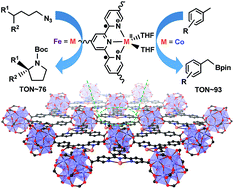当前位置:
X-MOL 学术
›
Chem. Sci.
›
论文详情
Our official English website, www.x-mol.net, welcomes your feedback! (Note: you will need to create a separate account there.)
Metal–organic layers stabilize earth-abundant metal–terpyridine diradical complexes for catalytic C–H activation
Chemical Science ( IF 8.4 ) Pub Date : 2017-10-30 00:00:00 , DOI: 10.1039/c7sc03537c Zekai Lin 1, 2, 3, 4 , Nathan C. Thacker 1, 2, 3, 4 , Takahiro Sawano 1, 2, 3, 4 , Tasha Drake 1, 2, 3, 4 , Pengfei Ji 1, 2, 3, 4 , Guangxu Lan 1, 2, 3, 4 , Lingyun Cao 1, 5, 6, 7, 8 , Shubin Liu 4, 9, 10 , Cheng Wang 1, 5, 6, 7, 8 , Wenbin Lin 1, 2, 3, 4, 5
Chemical Science ( IF 8.4 ) Pub Date : 2017-10-30 00:00:00 , DOI: 10.1039/c7sc03537c Zekai Lin 1, 2, 3, 4 , Nathan C. Thacker 1, 2, 3, 4 , Takahiro Sawano 1, 2, 3, 4 , Tasha Drake 1, 2, 3, 4 , Pengfei Ji 1, 2, 3, 4 , Guangxu Lan 1, 2, 3, 4 , Lingyun Cao 1, 5, 6, 7, 8 , Shubin Liu 4, 9, 10 , Cheng Wang 1, 5, 6, 7, 8 , Wenbin Lin 1, 2, 3, 4, 5
Affiliation

|
We report the synthesis of a terpyridine-based metal–organic layer (TPY-MOL) and its metalation with CoCl2 and FeBr2 to afford CoCl2·TPY-MOL and FeBr2·TPY-MOL, respectively. Upon activation with NaEt3BH, CoCl2·TPY-MOL catalyzed benzylic C–H borylation of methylarenes whereas FeBr2·TPY-MOL catalyzed intramolecular Csp3–H amination of alkyl azides to afford pyrrolidines and piperidines. X-ray absorption near edge structure (XANES), extended X-ray absorption fine structure (EXAFS), X-ray photoelectron spectroscopy, UV-Vis-NIR spectroscopy, and electron paramagnetic spectroscopy (EPR) measurements as well as density functional theory (DFT) calculations identified M(THF)2·TPY-MOL (M = Co or Fe) as the active catalyst with a MII-(TPY˙˙)2− electronic structure featuring divalent metals and TPY diradical dianions. We believe that site isolation stabilizes novel MII-(TPY˙˙)2− (M = Co or Fe) species in the MOLs to endow them with unique and enhanced catalytic activities for Csp3–H borylation and intramolecular amination over their homogeneous counterparts. The MOL catalysts are also superior to their metal–organic framework analogs owing to the removal of diffusion barriers. Our work highlights the potential of MOLs as a novel 2D molecular material platform for designing single-site solid catalysts without diffusional constraints.
中文翻译:

金属-有机层可稳定地球上大量的金属-吡啶双自由基配合物,从而催化C-H活化
我们报告了基于吡啶的金属有机层(TPY-MOL)的合成及其与CoCl 2和FeBr 2的金属化,分别得到CoCl 2 ·TPY-MOL和FeBr 2 ·TPY-MOL。经NaEt 3 BH活化后,CoCl 2 ·TPY-MOL催化甲基芳烃的苄基C–H硼化,而FeBr 2 ·TPY-MOL催化分子内C sp 3烷基叠氮化物的-H胺化反应可得到吡咯烷和哌啶。靠近边缘结构的X射线吸收(XANES),扩展的X射线吸收精细结构(EXAFS),X射线光电子能谱,UV-Vis-NIR光谱和电子顺磁能谱(EPR)测量以及密度泛函理论( DFT)计算确定M(THF)2 ·TPY-MOL(M = Co或Fe)为具有二价金属和TPY二价双价阴离子的M II-(TPY˙˙)2-电子结构的活性催化剂。我们认为,位点隔离可稳定MOL中的新型M II-(TPY˙˙)2−(M = Co或Fe)种类,从而赋予它们独特且增强的C sp 3催化活性。-H硼化和分子内胺化反应超过其均相对应物。由于消除了扩散壁垒,MOL催化剂也优于其金属-有机骨架类似物。我们的工作凸显了MOL作为新型2D分子材料平台的潜力,该平台可用于设计无扩散约束的单中心固体催化剂。
更新日期:2017-11-14
中文翻译:

金属-有机层可稳定地球上大量的金属-吡啶双自由基配合物,从而催化C-H活化
我们报告了基于吡啶的金属有机层(TPY-MOL)的合成及其与CoCl 2和FeBr 2的金属化,分别得到CoCl 2 ·TPY-MOL和FeBr 2 ·TPY-MOL。经NaEt 3 BH活化后,CoCl 2 ·TPY-MOL催化甲基芳烃的苄基C–H硼化,而FeBr 2 ·TPY-MOL催化分子内C sp 3烷基叠氮化物的-H胺化反应可得到吡咯烷和哌啶。靠近边缘结构的X射线吸收(XANES),扩展的X射线吸收精细结构(EXAFS),X射线光电子能谱,UV-Vis-NIR光谱和电子顺磁能谱(EPR)测量以及密度泛函理论( DFT)计算确定M(THF)2 ·TPY-MOL(M = Co或Fe)为具有二价金属和TPY二价双价阴离子的M II-(TPY˙˙)2-电子结构的活性催化剂。我们认为,位点隔离可稳定MOL中的新型M II-(TPY˙˙)2−(M = Co或Fe)种类,从而赋予它们独特且增强的C sp 3催化活性。-H硼化和分子内胺化反应超过其均相对应物。由于消除了扩散壁垒,MOL催化剂也优于其金属-有机骨架类似物。我们的工作凸显了MOL作为新型2D分子材料平台的潜力,该平台可用于设计无扩散约束的单中心固体催化剂。

























 京公网安备 11010802027423号
京公网安备 11010802027423号